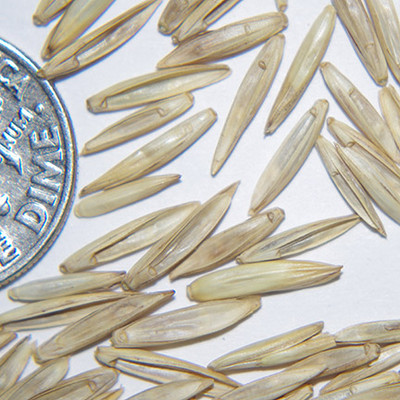Sold by the PLS pound
Botanical Name: Thinopyrum intermedium
Height: 36-48 inches
Intermediate Wheatgrass has fairly slow re-growth following clipping and is best adapted to single crop- haying situations (where rainfall patterns or limited irrigation prevents multiple cuttings in a season). Intermediate wheatgrass responds very well to irrigation with initial production nearing the level of orchardgrass (Dactylis glomerata) and meadow brome (Bromus biebersteinii) and exceeding smooth brome (Bromus inermis) under full irrigation. Meadow brome and orchardgrass have much better regrowth characteristics and will normally produce more than intermediate wheatgrass for hay production in multiple cutting situations.
Intermediate wheatgrass grows to 3 to 4 feet tall. It is a long-lived, cool season grass with short rhizomes and a deep feeding root system. Leaves are green to blue-green in color and sometimes drooping. Commercial seed of Intermediate wheatgrass often contains both pubescent and glabrous forms. Conditions to 11 or 12 inches of rainfall. It performs best between 3500 and 9000 feet elevation. It can be seeded at lower elevations, but moisture requirements are greater.
Establishment Planting
It should be seeded with a drill at a depth of 1/2 inch or less on medium to fine textured soils and no more than 1 inch deep on coarse textured soils. Recommended seeding rate is 8 pounds Pure Live Seed (PLS) per acre or 15 PLS seeds per square foot.
A firm weed free seedbed enhances stand establishment. It is compatible with other species, particularly alfalfa (Medicago spp.). In a mixture with alfalfa, stand longevity and productivity is often enhanced. If used as a component of a mix, adjust seeding rates to percent of mix desired. The best dryland results are obtained from seeding in very early spring on heavy to medium textured soils and in late fall (dormant) on medium to light textured soils. Irrigated lands should be seeded in spring through summer. Late summer (August - mid September) seedings are not recommended unless irrigation is available.
Uses
Grazing/pastureland/hayland: This is an introduced species used for hay and pasture in the northern Great Plains, west to central Washington, and south into Colorado, Kansas, and northern New Mexico and Arizona.
Wildlife: Strips of intermediate wheatgrass left ungrazed provide good nesting cover for game birds and migratory waterfowl.
Erosion control/reclamation: Intermediate wheatgrass is well adapted to the stabilization of disturbed soils. This grass can be used in critical and urban areas where irrigation water is limited and to stabilize ditchbanks, dikes, and roadsides. This grass can also be use to build soils because of its heavy root production. Levels as high as 7000 pounds (dry weight) per acre of root production in the upper 8 inches of soil have been measured in five-year-old stands.
Information from USDA NRCS Intermediate Wheatgrass Plant Guide







